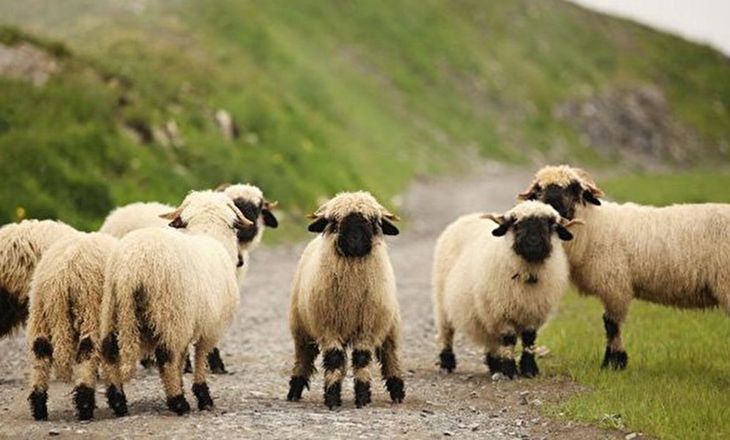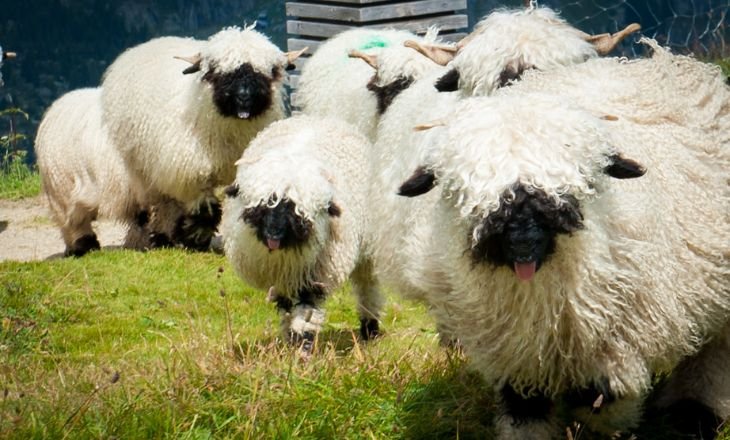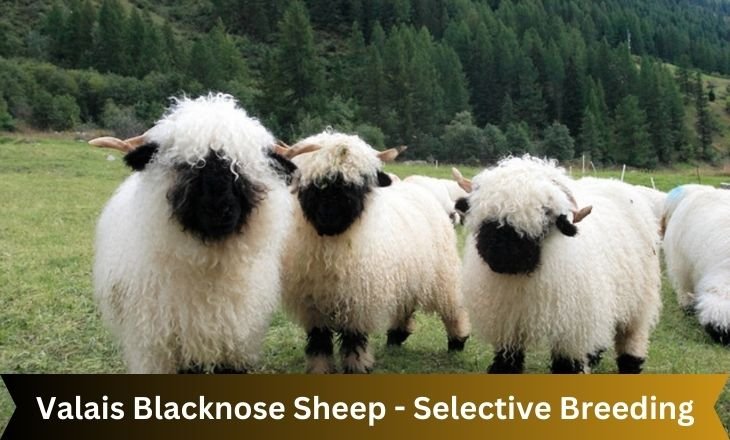In Switzerland, there is a type of sheep called the Valais Blacknose Sheep. They have black faces and white fluffy fleece, making them cute and popular. These sheep have a unique look that represents Swiss beauty. They were bred over many years to look this way. The
Valais Blacknose Sheep have a long history and are known for their special traits. They originated in the Valais region and are now famous globally for their unique appearance and skills.
Valais Blacknose Sheep
Valais Blacknose Sheep are very popular because they look cute and are friendly. They come from Switzerland and have black faces and legs with white woolly coats. People like them for their good wool and meat. These sheep are gentle and calm, so hobby farmers and petting zoos like them.
Popular Sheep
Valais Blacknose Sheep have fluffy faces and black markings. People worldwide love them for their looks and friendly personalities. These sheep are valuable for their wool and meat. Merino sheep are also popular for their soft wool, which is highly sought after.

Originally from Spain, Merinos are now bred worldwide and can thrive in various environments. They are smart and gentle, making them a top choice for farmers. Sheep such as Valais Blacknose and Merino are important in farming and textile production.
The Most Beautiful Sheep In The World
Valais Blacknose sheep are popular for being the cutest because of their fluffy coats and dark face markings. They are well-liked on social media for their unique look and friendly nature.
Merino sheep, originally from Spain but now found worldwide, are known for their soft and luxurious wool. Their fine, crimped fibers provide great warmth and breathability, making Merino wool highly sought after in fashion for its quality and versatility.
Each Merino sheep has this natural luxury in its fleece, making them one of nature’s most beautiful creations.
Dancing Sheep
Imagine a field with white sheep dancing gracefully in the sun. They charm viewers with their movements, blending grace and fun in a dreamlike way. Each sheep has its dance style, some spinning perfectly and others playfully jumping. They communicate through movement, creating a captivating show of unity and beauty.
Average Age Of Sheep
Sheep live for varying lengths depending on their breed, environment, and health. Valais Blacknose sheep are strong and can live up to 12-14 years. Generally, sheep live between 6-14 years. Older sheep may have difficulty reproducing or producing wool compared to younger ones.
Age Of Sheep By Teeth
Shepherds can tell a sheep’s age by looking at its teeth, and experts can estimate the sheep’s age accurately by checking the wear on the front and back teeth. This method is used in traditional farming areas without advanced vet tools.
Some sheep breeds have unique tooth patterns that help determine their ages. Black sheep have teeth that change as they get older. Farmers can monitor these teeth to track the sheep’s growth and provide appropriate care based on their age.
Lamb Meat Age Of Sheep
Sheep age affects lamb meat quality and flavour. Young sheep under one year old have tender, mild meat known as spring lamb. Older sheep, over two years old, produce richer, intense-flavored meat called hogget or mutton.
Young lamb is lean and has a simple taste, which is good for low-fat diets. Older sheep have more healthy fats, like omega-3, which benefit heart health. Consider sheep age for taste and nutrition when choosing lamb meat.
What Are 5 Interesting Facts About Sheep?
Sheep have good memories and can remember up to 50 sheep and human faces. They have good side vision to see predators. Some sheep lead their groups instead of following. When they sense danger, they can make different sounds to communicate, like happy bleats or alarm calls.
Most Expensive Sheep Wool
Shahtoosh wool is very soft and luxurious, making it one of the most expensive sheep wools globally. Its thin fibres are spun into delicate, lightweight shawls that are warm and breathable. Vicuna wool, from the Vicuna animal in South America, is also a top contender for expensive sheep wool.
Most Expensive Sheep
In 2020, a Scottish sheep named Double Diamond Sheep set a new record as the world’s most expensive selling for $490,000. This high price highlights the increasing popularity of breeding elite sheep with perfect genetics.
The agricultural industry values pedigree and superior traits in breeding programs, leading to a growing demand for top-quality genetics and increasing prices.

Health Problems
The Valais Blacknose Sheep has a thick, curly coat and a black face. It needs special care to stay healthy. Even though it may seem strong, it can still get sick if not cared for properly.
Regular check-ups and preventive measures are important to keep black sheep healthy and avoid problems in the future. Taking care of a Blacknose Sheep helps it stay strong and live longer.
Interdigital Dermatitis
Interdigital dermatitis, or foot rot, is a common problem in sheep that can be painful and affect their well-being. It happens when moisture and bacteria build up between the sheep’s toes, causing inflammation and discomfort. Shepherds should check their sheep’s feet regularly and take steps to prevent and treat foot rot.
Footrot
Footrot is a scary infection for livestock owners. It causes discomfort and can harm the whole herd. To fight foot rot, it’s important to trim hooves regularly and keep living areas clean and dry. Studies show that a good diet can help sheep resist foot rot. A balanced diet with essential nutrients can boost the immune system and make the sheep less likely to get infections like foot rot.
Shelly Hoof Sheep
The Shelly Hoof Sheep is a special breed with unique markings and a strong body. It is popular in farming because it is tough and adaptable to different climates. These sheep were first bred in the hills of New Zealand and are known for thriving in harsh conditions.
Their thick coats help them stay warm in cold weather and cool in hot weather. One interesting feature is their hooves, which resemble seashells and inspired their name.
How To Take Care Of Sheep
Caring for sheep requires a balanced diet, fresh water, good-quality forage, and minerals. Shearing their wool yearly helps keep them cool and prevents problems like flystrike. Regularly checking their health and addressing any problems quickly will help keep your sheep happy and healthy.

Conclusion
Selective breeding has been crucial in preserving and enhancing the Valais Blacknose sheep breed.
Breeders have improved these unique sheep’s overall health, appearance, and productivity through carefully selecting desirable traits and genetic management.
Breeders’ dedication and expertise have ensured that this rare and beautiful breed continues to thrive in today’s agricultural landscape.
As we look to the future, it is important to continue supporting responsible breeding practices to safeguard the heritage and legacy of the Valais Blacknose Sheep for generations to come.
Let us all join hands in celebrating and protecting these magnificent creatures that bring so much joy and value to our world.
Frequently Asked Question
What Is the World’s Most Famous Sheep?
The world’s most famous sheep is Dolly.
What Is The Cutest Sheep?
The Babydoll Southdown sheep is often considered one of the cutest sheep breeds.
How Long Are Valais Sheep Pregnant For?
A ewe is pregnant for about 21 weeks. This time can change based on the breed, nutrition, age of the sheep, number of fetuses, and temperature.
Are Valais Blacknose Sheep Aggressive?
Valais Blacknose sheep are friendly and calm. This makes them great pets compared to other sheep breeds.

